Hi, I’m Chelsea, and I’ll be your guide today to the Möbius Gradebook! I’ll take you through what makes the Möbius Gradebook stand out for managing student grades in Möbius.
 With grading being the least favourite part of an educator’s day, I’ll show you how the Möbius Gradebook gets you through your grading tasks faster, while still giving you access to valuable and actionable insights when it comes to your students’ performance. This means you get through your grading and back to doing what you actually love: teaching!
With grading being the least favourite part of an educator’s day, I’ll show you how the Möbius Gradebook gets you through your grading tasks faster, while still giving you access to valuable and actionable insights when it comes to your students’ performance. This means you get through your grading and back to doing what you actually love: teaching!
Möbius is a comprehensive teaching platform that supports you in online lesson and assignment delivery, with an added perk of automatic grading! And this is where the Möbius Gradebook comes in! But, if you want to take a different path towards paper-based grading, be sure to check out Möbius Grading—a collaborative tool for the digital grading of paper-based assessments, including bubble sheet multiple choice questions!
Check out DigitalEd MythBusters: Möbius VS Möbius Grading to learn more about the difference between these two powerful grading tools.
OK, back to the Möbius Gradebook that’s inside of Möbius!
There are a ton of powerful functionalities of the Möbius Gradebook that enable you to have fine control over student grades (even when the questions are automatically graded!), take a closer look at specific student responses, and perform a bunch of other important tasks related to managing grades in order to refine your course delivery.
Let’s go! Follow me!
View student grades with the gradebook
Be selective in how you want to view your students’ grades. An incredible selection of filters and options are presented to you the second you click on the Möbius Gradebook:
-
- Choose the assignment grades you want to view (or select multiple)
- Select specific users, date ranges, grade ranges, and statuses of student attempts
- Pinpoint the different types of attributes you want to have visible, like student IDs, the number of attempts students made at the assignment, and what time they submitted their attempt
- And so much more!
Here’s the starting point of the Möbius Gradebook where you can choose from a great selection of options and filters when selecting the grades you want to view:
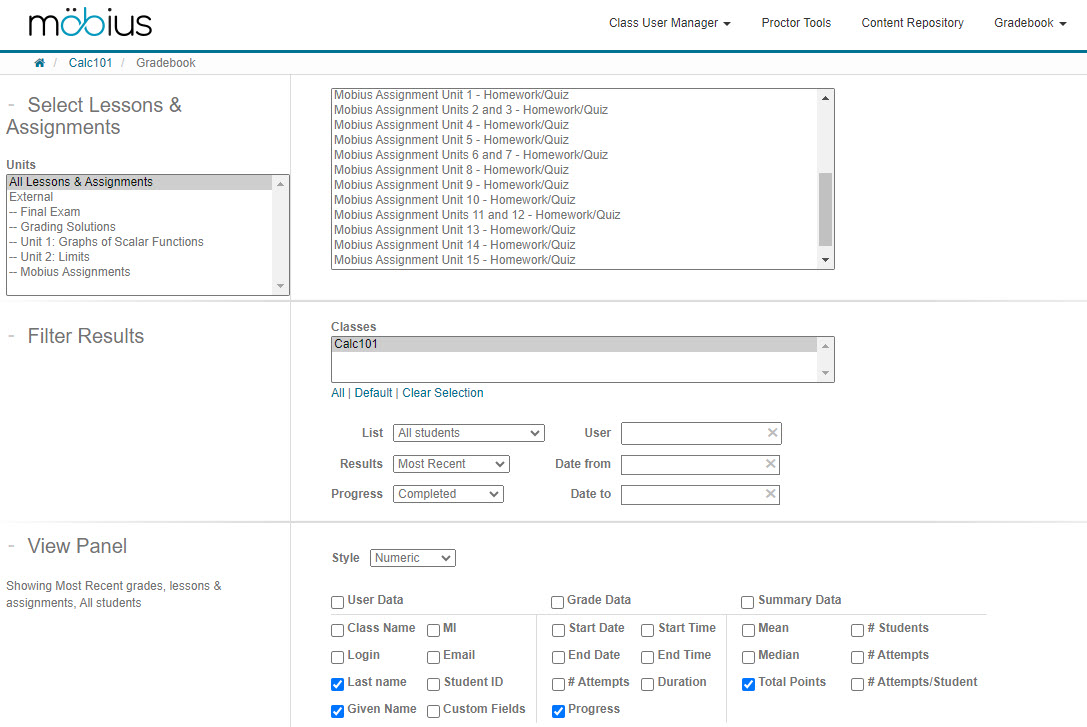
You can then choose to view the generated report by:
-
- Individual student submissions to an entire assignment, or
- All student submissions to a specific question, or
- All student submissions to an entire assignment
The possibilities and combinations of grade information are endless in the Möbius Gradebook, enabling you to find exactly what you’re looking for when analyzing student performance, enabling you to optimize your course based on your findings.
Individual and bulk grade editing
Automatic grading of sophisticated STEM questions is one of Möbius’ superpowers.
Möbius can automatically grade algorithmic questions that use variables to give an infinite number of versions of the question, and it can automatically grade open-ended questions that have infinite numbers of correct answers. It can even grade really elaborate STEM-focused questions like free-body diagram questions and sketching (graphing) questions. It can even automatically award partial grades to students who almost got the full premise of the question, but just missed something small.
But, just because Möbius has done all of the grading work for you doesn’t mean you don’t have any control! You absolutely have the ability to access the Gradebook and modify grades if needed.
It’s not that you’d need to edit a grade because Möbius has made a mistake and can’t be trusted! It’s more that perhaps a student misinterpreted a question, sent you an email, and you agree to mark their response correct even though technically it wasn’t quite what the question asked for. You can even go in and award partial grades, yourself, if you want!
Say you want to give all of your students a different grade, maybe because of a mass misunderstanding of something in the question. You can do this with bulk grade editing! Just make the grade changes once and apply it to all of your students with a few simple clicks:
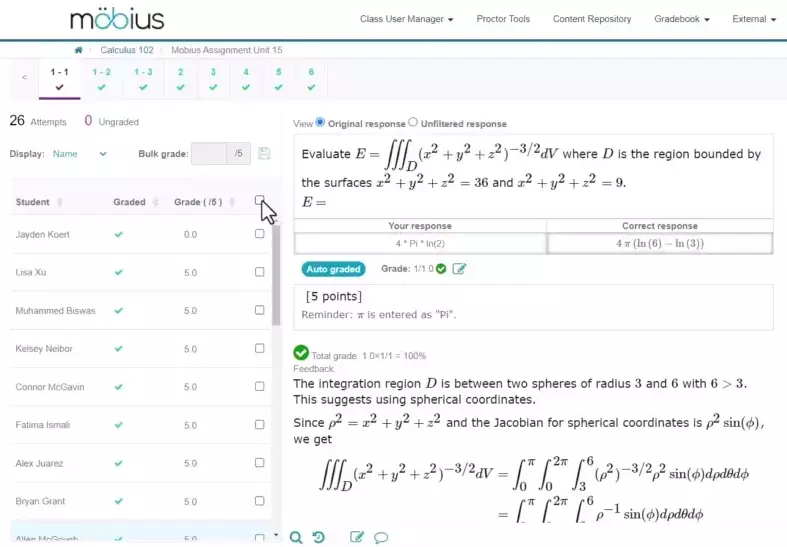
Manually grade questions
While Möbius is built on the ability to automatically grade questions online, you still have the flexibility to intersperse manual review questions—like an essay question—that you’ll review yourself to really gauge student comprehension.
That means you can create assignments with automatically-graded questions but also include opportunities for long answer responses, essay responses, and mathematical proofs for students to explain their understanding of a concept or show their work to explain how they got to an answer.
While grading these types of questions, you’ll have access to a bunch of handy editing tools like keyword highlighting, annotation commenting, and word counts.
But you don’t have to do this grading alone. With the Activity Grading View of the Möbius Grade Manager, it’s specially designed to update in real time when a student’s response has been graded, so you can work with a team to tackle grading of online Möbius assignments that include typed long answer responses. Checkmarks update in real-time to show the graded status of student submissions in the Grade Manager’s Activity Grading View (even for essay questions!):
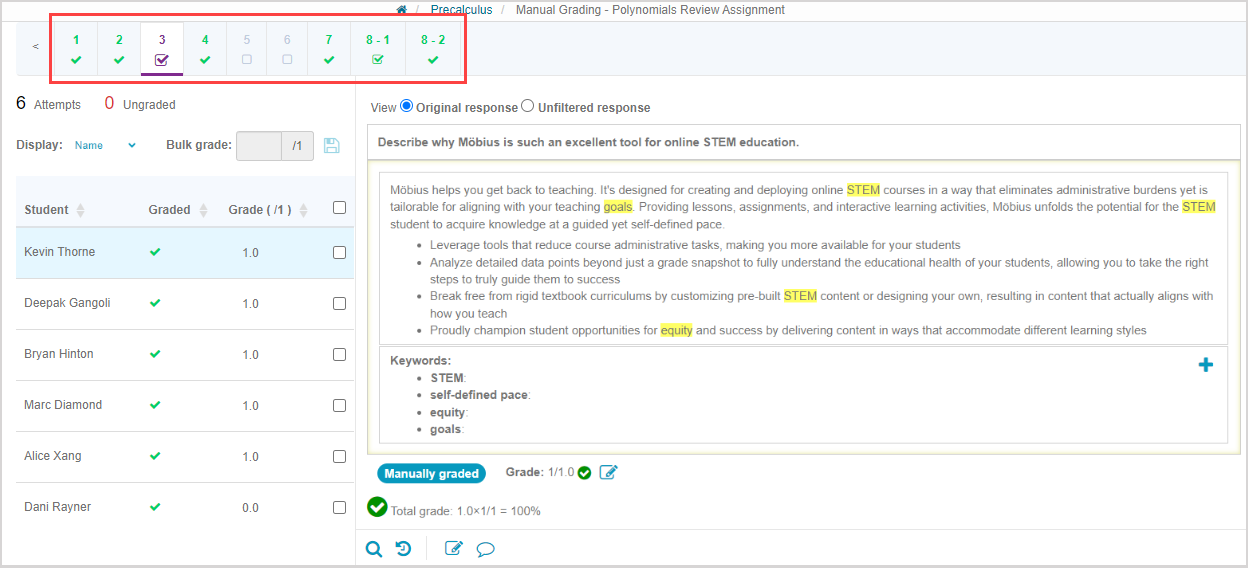
Regrade questions
Unlike Möbius, we—as humans—aren’t always perfect.
Sometimes, we make a mistake in authoring a question or defining what the correct answer is. And then, when we’re flooded with student complaint emails about how they were sure they got question #1 right but Möbius marked them wrong, it feels like it’s a lot of work to go back and regrade the question for every single student.
But Möbius makes regrading easy. You can easily jump back into the assignment question, make the needed edit (even when it’s already been attempted by your students!), and then slide into the Möbius Gradebook and click to regrade the assignment:
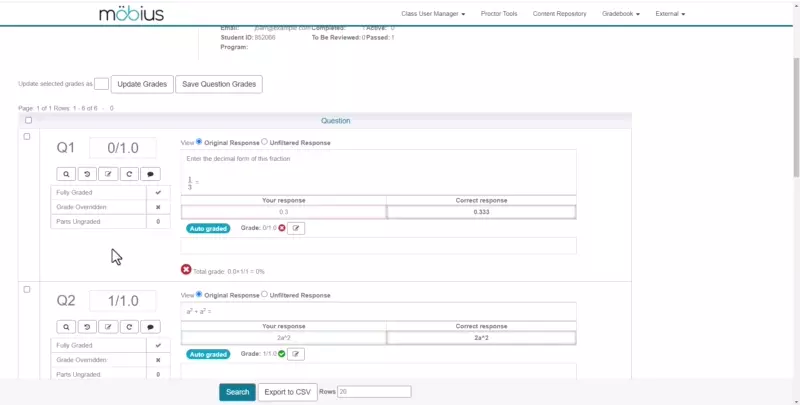
There. With a few simple clicks, you can regrade your entire class and update their grades. No stress!
Gradebook analytics
There’s a really cool four-part blog series called More Than Just Grades that explains all of the different types of analytical data available to you while working with Möbius (and Möbius Grading).
With there being more to a student’s journey than just looking at a single grade snapshot, passionate and data-driven educators will really love the detailed insights that Möbius’ grading solutions offer, ranging from in-depth statistics into question performance to how many times a student engages with a piece of content. This data means you can understand where students need help and which parts of your curriculum need improvement.
Here’s one of the dashboards that you can use to take a closer look at your students’ engagement with your content:
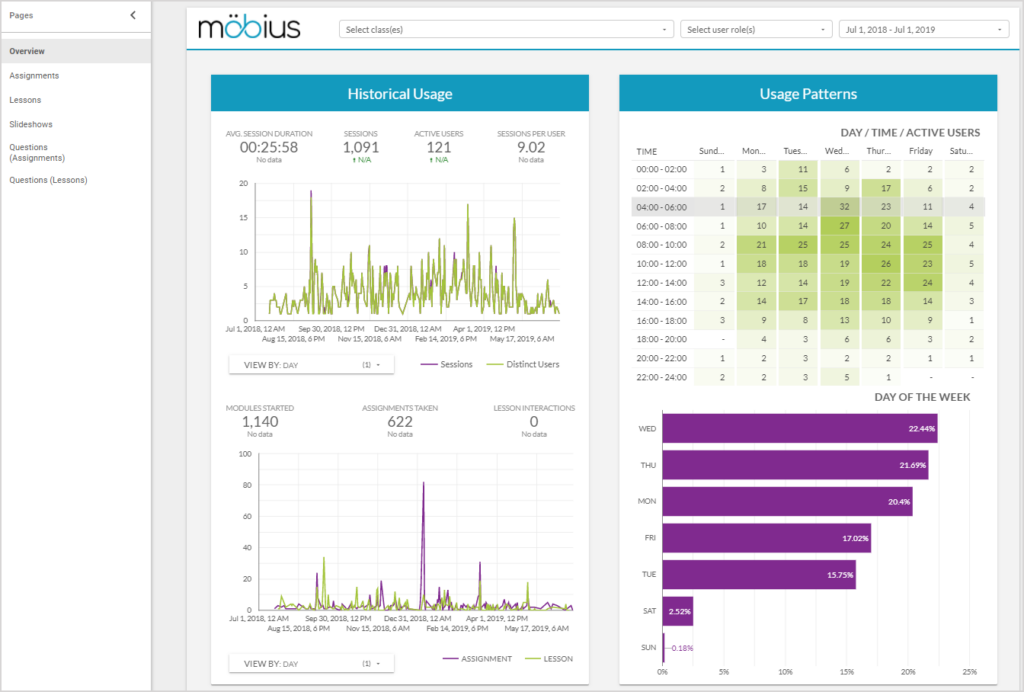
Check out these More Than Just Grades deep dives into understanding how you can use data collected from student performance to nurture them to successful outcomes, making your course the best that it can be:
-
- PART I: Evaluate the Performance of Your Questions (Möbius)
- PART II: Grade Reports for Student Overviews (Möbius)
- PART III: Engagement Insights with Möbius Analytics (Möbius)
- PART IV: Data Even From Paper-Based Grading (Möbius Grading)
All of these abilities within the Möbius Gradebook are designed to optimize your teaching workflows, and get you out of the tedious administrative tasks of course delivery and grading, and get you back to teaching, which is the whole reason you became an educator in the first place!
We’d love to learn about the goals you have when it comes to grading your online assessments, and show you how the Möbius Gradebook is just one aspect of Möbius that gets you past grading and back to teaching quicker. Let’s connect!

